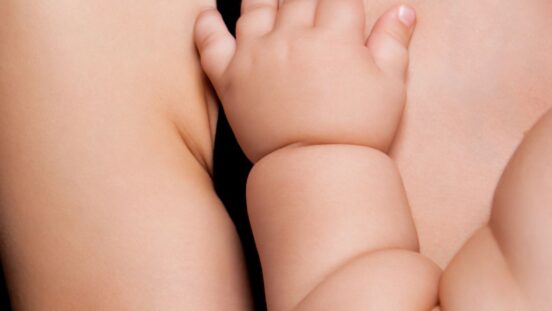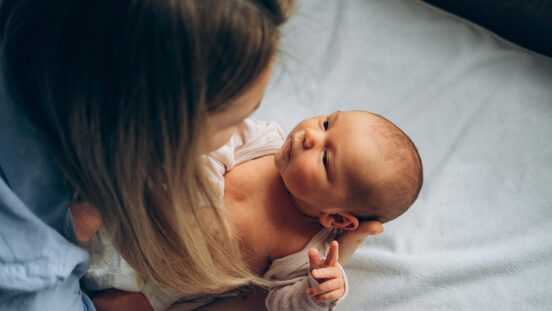Avoiding baby’s dry skin in winter

Winter and cold weather plus heating equals problems for baby’s delicate skin – these tips will help you manage and prevent dry skin in babies.
Winter and cold weather is not the best combination for your baby’s skin, and if you add warm, drying heaters to the mix, it’s no wonder winter often leads to chapping and dry skin, especially on unprotected areas like the face and hands.
Here are some tips to help keep your baby’s skin in great condition.
What causes baby’s dry skin and what to do about it
Moisture, baby – keep their skin soft
Babies are more prone to dry, irritated skin during winter, due to the dry air and the indoor heating drying out the atmosphere. Keep him protected with plenty of unscented moisturiser, applied liberally throughout the day.
Don’t be alarmed by a newborn baby’s skin that may appear dry and peeling. This is common – think of it like nature is exfoliating the outer layer, and apply a baby-friendly moisturiser.
Dotting some moisturiser on those chubby cheeks before you head outside may protect from wind burn, too.
If dry skin persists or your tot develops eczema, you may need to see your health visitor or GP.
Heating up – layers are key
In the winter, there are big differences in the temperature outside and in, and while you’ll take a jumper off if you feel hot, your baby can’t. Plus his body’s still learning how to regulate his temperature, which makes him doubly prone to overheating.
The problem is made worse if he’s bundled in thick clothes, which can lead to sweating and skin irritation. Dress your baby in lots of think layers so you can adjust his clothing and easily keep him at the right temperature.
Bath time – keep it cool and natural
Bathing your baby too regularly can dry his skin out even more, so keep winter baths to a minimum – once every two days is fine. You can just top and tail him on the other days. Stick to plain, bubble-free water in the first few months to avoid irritation and keep bath time short.
After his bath give him a soothing massage with a baby-friendly massage oil. This will relax him and keep his skin soft.
Dressing down – go natural
Consider the fabrics you dress your baby in – try to choose clothes made from natural fabrics that allow his skin to breathe. If your baby gets overheated in his clothes, it could irritate his skin and may worsen eczema or cradle cap.

All about eczema
Around 1.6 million Australians suffer from eczema and of those with it, 90% will develop the condition before the age of five. For some babies, eczema appears as an itchy rash, while others experience weeping sores and scaly skin.
Eczema can be inherited, caused by an allergy (atopic eczema) or due to a combination of the two. The most common type is atopic (allergic). It generally runs in families and is often linked with other atopic conditions such as asthma and hay fever. It causes dry, red, itchy and inflamed skin. If your baby scratches, her skin may crack and bleed, leading to infection and weeping sores.
An eczema flare-up may be triggered by an inherited tendency to allergies, being run down, unwell, or drastic changes in temperature (like switching the heater on).
There’s no cure for eczema, but there are ways to soothe it. Your GP may recommend antihistamines, which can ease itching, or steroids (in the form of cream, ointment or medicine) to reduce inflammation and relieve discomfort. Wet-wrap bandaging (damp cotton bandages soaked in emollient cream, covered with dry bandages and kept on for up to 24 hours) can help to seal in moisture and prevent scratching.

Crusty head – cradle cap
Cradle cap, or infantile seborrhoeic eczema, is also very common. Although it looks unsightly, with a greasy scalp and flaking skin scales, it’s not sore or itchy. It will go away without treatment, but if you want to get rid of the loose flakes of skin, massage your baby’s scalp with olive oil before bed.
The next day, comb her hair with a fine-toothed comb, then wash with a mild shampoo such as Swisspers Baby Gentle Shampoo, which comprises extra gentle Australian Cotton Milk, Certified Organic Aloe Vera and Vitamin E. If this doesn’t work, you can buy cradle cap creams from your pharmacy




